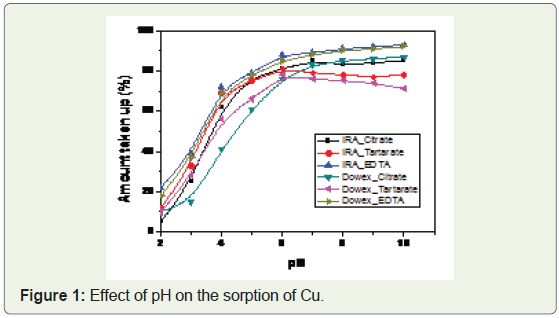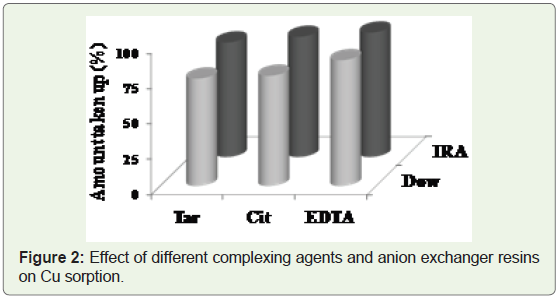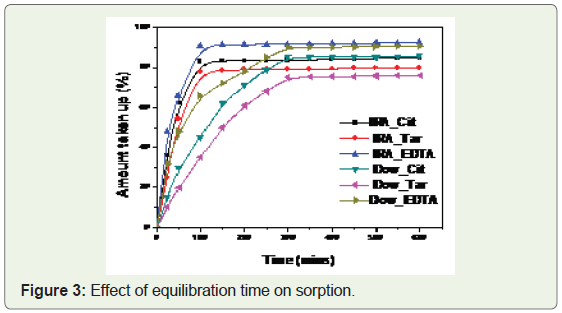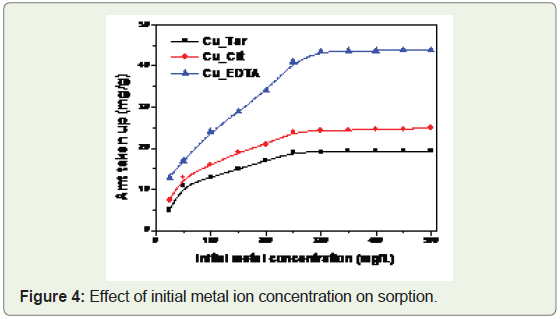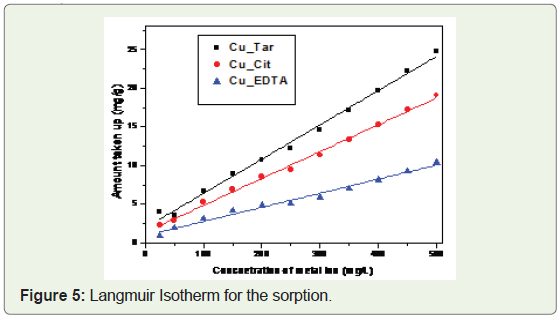Research Article
Sorption of Anionic Copper Complexes by Anion Exchanger Resins
Jayshree R* and Chandramouleeswaran S
Analytical Chemistry Division, Bhabha Atomic Research Centre, India
Corresponding author: Jayshree R, Analytical Chemistry Division, Bhabha Atomic Research Centre, Mumbai-400085, India, E-mail: jrk@barc.gov.in
Citation: Jayshree R, Chandramouleeswaran S. Sorption of Anionic Copper Complexes by Anion Exchanger Resins. J Chem Applied Biochem. 2018;5(1): 123.
Copyright © 2018 Jayshree R, et al. This is an open access article distributed under the Creative Commons Attribution License, which permits unrestricted use, distribution, and reproduction in any medium, provided the original work is properly cited.
Submission: 21/06/2018; Accepted: 13/08/2018; Published: 20/08/2018
Abstract
Removal of copper from aqueous solutions as its anionic complex by batch mode studies was carried out using IRA-400 and Dowex1X4 anion exchange resins. The amount removed was studied as a function of various experimental parameters like amount of sorbent, pH of the solution, equilibration time etc. The sorption capacity (Q0) of tartrate, citrate and EDTA anionic complexes on IRA resin was calculated from the Langmuir isotherm and found to be 22,29,63 mg/g respectively. Kinetic modeling revealed that the sorption followed pseudo second-order kinetics.
Introduction
Industrial effluents may contain metal ions which maybe toxic or precious thus requiring the need to remove them prior to discharge. Several studies on different species in aqueous solutions have been reported [1-3]. Copper is one such metal ion which has received attention due to its toxicity [4-10]. However in actual applications, a combination of different procedures becomes very attractive.
In this study, ion exchange sorption of copper from copper containing synthetic solution using anion exchange resins IRA-400 and Dowex1X4 have been carried out with an aim of evaluation the capacity of these resins to remove copper from industrial effluent and get a comparison between the sorption properties of the two resins. Various parameters like equilibration time, pH of the solution, amount of resin have been varied in order to get an optimized condition for maximum sorption and also an attempt has been made to evaluate and compare the sorption capacity of the resins and sorption kinetics of copper ion from aqueous solutions. All these studies will help in understanding the sorption behavior and the developed method was applied to actual industrial effluent sample.
Experimental
Anion exchange resins IRA-400 and Dowex1X4 were obtained from Aldrich Chemical Company. Stock solutions of metal ions were prepared by dissolving their chloride salts (AR Grade, E. Merck) in dilute hydrochloric acid. Solutions of tartaric and citric acid and EDTA were prepared by dissolving the appropriate amounts the AR grade reagent in deionised water. The metal ion concentrations in the samples were determined using ICP OES. The pH adjustments were made using Elico LI 610 pH meter.
In order to carry out the sorption, copper is converted to its anionic citrate or tartrate complexes. This was carried out by adding a slight excess of the ligand. A very high amount of ligand (tartrate/citrate/EDTA) was also not advisable as the ligand itself would be taken up by anion exchanger resin. Sorption studies of these anionic forms were performed on two different anion exchange resins (IRA-400 and Dowex1X4). In order to study the effect of pH on the sorption, the sorbent amount (0.1 g of each of the resin) and copper solution concentration (10 mL of 10-2M Cu) were separately used and the pH of the solution was varied over the entire range. In order to correct for any sorption of copper on the container surface, control experiments were carried out without resins. It was found that there was no sorption by the container walls. In addition, all mixing vessels were kept sealed throughout the duration of each isotherm test to minimize dissolution of gaseous species in the atmosphere. Kinetic studies were carried out using a constant concentration of metal ion, amount of resin and pH while the equilibration time was varied. Once the time of equilibration resulting in maximum sorption was obtained, the sorption isotherm studies were carried out using constant pH, time and amount of resin while the concentration of the metal ion was varied.
Results and Discussion
The studies were carried out using 10-2 MCu2+ solution. This was chosen quite close to the amount present in the effluent of electrolytic industry.
In order to find out the optimum pH for maximum sorption, studies were carried out using 10 ml of 10-2M Cu and 0.1g of resin and pH was varied in the range of 2-10. The results are shown in Figure 1. From Figure 1, it is evident that the sorption was quite good with both the resins but interesting features were observed. It was seen that for a particular chelating agent, the trend shown by both the resins is the same. It was seen most of the optimum pH of 6 could be used for further studies.
Figure 2 gives a variation of the amount sorbed as a function of the chelate and the resin used at a particular pH (6). It is seen that amount sorbed is dependent on the nature of the ligand used. It is seen that the order of sorption is EDTA>citrate> tartrate and this can be explained on the basis of the order of stability constant of metal chelate. The log K values of copper complex of EDTA, citrate and tartrate complexes are 18, 6 and 3.2 respectively. Therefore stronger is the metal chelate, greater is the sorption. The nature of resin also has an effect on the sorption. It is that amount of sorption is slightly higher for IRA as compared to Dowex resin. This could be attributed to the higher exchange capacity of IRA (3.65meq g−1 of dry mass) as compared to that of Dowex resin (2.7 meq g−1 of dry mass).
The effect of variation of resin amount on the sorption was studied by varying the amount in the range of 0.1 to 1.0 g with an equilibration time of 6 h at an initial copper ion concentration of 10-2M. It was seen that for citrate complex, 0.2 g of both the resins gave maximum sorption. For tartrate complex, the amounts of IRA and Dowex were 0.3 and 0.5 g respectively. However for EDTA complex, the maximum sorption was achieved with 0.1 g. The differences in the amount needed again could be attributed to difference in the stability constant of the complexes and also the ion exchange capacity values of the resins.
The effect of equilibration time on the sorption of copper is given in Figure 3. The removal increases with time and attains equilibrium in 100 min for IRA-400 resins and 300 min for Dowex1X4. This is in correlation with the results obtained for the pH and sorbent amount variation. The entire metal uptake versus time curves is single, smooth and continuous leading to saturation, suggesting the possible monolayer coverage of metal ions on the surface of the sorbent.
Since it was seen that IRA resin showed better sorption behavior as compared to Dowex resins, further studies on the effect of initial concentration were carried out using IRA resin and the results are shown in Figure 4. The studies were carried out by varying the concentration in the range of 0-500 mg/L.
Sorption isotherms are critical in optimizing the use of adsorbents as they describe the nature of interaction between sorbate and sorbent. Therefore, the experimentally obtained results are fitted to equilibrium model. The effect of initial metal ion concentration on the amount taken up is known as an adsorption isotherm (Figure 4), which is a curve that illustrates the retention ion from the aqueous phase onto a solid-phase at a constant temperature and pH. An equilibrium is established when the sorbent (resin) is in contact with the sorbate (ion) for a sufficient time period. The mathematical correlation that can be represented graphically is useful for modeling analysis to understand the uptake efficiency of sorbents. Langmuir isotherm is one of the best used isotherms that can give the maximum uptake capacity of a particular sorbent [11]. It is based on certain basic assumptions like monolayer adsorption (the adsorbed layer is one molecule in thickness), at a finite (fixed) number of definite localized sites, that are identical and equivalent, with no hindrance between the adsorbed molecules, even on adjacent sites. This indicates a homogeneous sorption resulting in equilibrium saturation as given by the plateau in the graph. The mathematical linear expression of Langmuir isotherm is given by Equation 1.
The Langmuir plots are shown in Figure 5. From the inverse of the slope the values of maximum uptake capacity can be calculated.
From the Langmuir isotherm, the maximum capacity of the tartrate, citrate and EDTA complexes were 22,29,63 mg/g respectively on the IRA resin. The sorption kinetics was evaluated by treating the time variation data with the pseudo first and second order models [12]. From the studies, it is seen that the second order model has a very good fit indicating that the sorption is chemisorption in nature [12].
Conclusion
The use of anionic exchangers for uptake of copper from pure solution has been studied. It was seen that the nature of the chelating agent had a strong effect on the sorption behavior. It was also seen that the sorption was enhanced by the use of IRA resin as compared to Dowex Resin. The pH variation showed maximum uptake can be achieved in a near neutral medium.
References
- Jayshree R (2017) Understanding the Sorption of Thionine Dye. Acta Chim Pharm Indica 7: 110-113.
- Dutta DP, Anamika S, Jayshree R, Kaustava B, Tyagi AK, et al. (2014) Exploration of sorption properties of sonochemically synthesized BaMoo4 nanoparticles for hazardous cationic dye removal. Advanced Porous materials 2: 1-9.
- Jerina M, Jayshree R, Chandramouleeswaran S, Tyagi AK (2015) Effect of synthesis protocol on the surface charge of zinc oxide nanoparticles and its consequence on sorption ability. Sep Sci Technol 50: 404-410.
- Jerina M, Jayshree R, Chandramouleeswaran S, Tyagi AK (2014) Highly selective uptake of Copper (II) ions from aqueous media using nanosorbents in batch mode. Advanced Porous Materials 2: 1-10.
- Mukherjee J, Dutta DP, Jayshree R, Tyagi AK (2016) A comprehensive study on the uptake of dyes, Cu(II) and radioactive 137Cs(I) by sonochemically synthesized strontium/yttrium tungstate and molybdate nanoparticles. J Environ Chem Eng 4: 3050-3064.
- Dutta DP, Mathur A, Jayshree R, Tyagi AK (2014) Sorption of dyes and Cu(II) ions from wastewater by sonochemically synthesized MnWO4 and MnMoO4 nanostructures. RSC Adv 4: 1-23.
- Jayshree R, Chandramouleeswaran S (2017) Barium borosilicate glasses: Room temperature sorbents for radioactive and transition metal ions. J Chem Applied Biochem 4: 1-5.
- Mukherjee J, Jayshree R, Chandramouleeswaran S, Shukla R, Tyagi AK (2013) Sorption characteristics of nano manganese oxide: efficient sorbent for removal of metal ions from aqueous streams. J Radioanal Nucl Chem 297: 49-57.
- Reddy TR, Jayshree R, Chandramouleeswaran S, Reddy AVR (2010) Selective transport of copper across a bulk liquid membrane using 8-hydroxy quinoline as carrier. J Memb Sci 351: 11-15.
- Jayshree R, Chandramouleeswaran S, Sudarsan V, Vatsa RK, Shobha S, et al. (2010) Boroaluminosilicate glasses as ion exchange materials. J Non Cryst Solids 356: 2813-2819.
- Jerina M, Jayshree R, Chandramouleeswaran S, Jayakumar OD, Tyagi AK (2013) Kinetic modeling: dependence of structural and sorption properties of Zno-crucial role of synthesis. RSC Adv 3: 3365-3373.
- Singh A, Dutta DP, Jayshree R, Bhattacharya K, Tyagi AK, et al. (2013) Serendipitous discovery of super adsorbent properties of sonochemically synthesized nano BaWO4. RSC Adv 3: 22580-22590.

